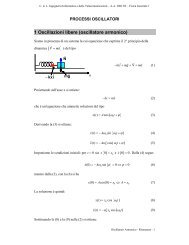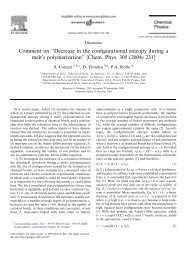Communication Theory of Secrecy Systems - Network Research Lab
Communication Theory of Secrecy Systems - Network Research Lab
Communication Theory of Secrecy Systems - Network Research Lab
You also want an ePaper? Increase the reach of your titles
YUMPU automatically turns print PDFs into web optimized ePapers that Google loves.
is that the decipherer knows the particular key being used, while the cryptanalyst<br />
knows only the a priori probabilities <strong>of</strong> the various keys in the set.<br />
The process <strong>of</strong> deciphering is that <strong>of</strong> applying the inverse <strong>of</strong> the particular<br />
transformation used in enciphering to the cryptogram. The process <strong>of</strong> cryptanalysis<br />
is that <strong>of</strong> attempting to determine the message (or the particular key)<br />
given only the cryptogram and the a priori probabilities <strong>of</strong> various keys and<br />
messages.<br />
There are a number <strong>of</strong> difficult epistemological questions connected with<br />
the theory <strong>of</strong> secrecy, or in fact with any theory which involves questions<br />
<strong>of</strong> probability (particularly a priori probabilities, Bayes’ theorem, etc.) when<br />
applied to a physical situation. Treated abstractly, probability theory can be<br />
put on a rigorous logical basis with the modern measure theory approach 45 .<br />
As applied to a physical situation, however, especially when “subjective”<br />
probabilities and unrepeatable experiments are concerned, there are many<br />
questions <strong>of</strong> logical validity. For example, in the approach to secrecy made<br />
here, a priori probabilities <strong>of</strong> various keys and messages are assumed known<br />
by the enemy cryptographer—how can one determine operationally if his estimates<br />
are correct, on the basis <strong>of</strong> his knowledge <strong>of</strong> the situation?<br />
One can construct artificial cryptographic situations <strong>of</strong> the “urn and die”<br />
type in which the a priori probabilities have a definite unambiguous meaning<br />
and the idealization used here is certainly appropriate. In other situations that<br />
one can imagine, for example an intercepted communication between Martian<br />
invaders, the a priori probabilities would probably be so uncertain as to<br />
be devoid <strong>of</strong> significance. Most practical cryptographic situations lie somewhere<br />
between these limits. A cryptanalyst might be willing to classify the<br />
possible messages into the categories “reasonable”, “possible but unlikely”<br />
and “unreasonable”, but feel that finer subdivision was meaningless.<br />
Fortunately, in practical situations, only extreme errors in a priori probabilities<br />
<strong>of</strong> keys and messages cause significant errors in the important parameters.<br />
This is because <strong>of</strong> the exponential behavior <strong>of</strong> the number <strong>of</strong> messages<br />
and cryptograms, and the logarithmic measures employed.<br />
3 REPRESENTATION OF SYSTEMS<br />
A secrecy system as defined above can be represented in various ways. One<br />
which is convenient for illustrative purposes is a line diagram, as in Figs. 2<br />
and 4. The possible messages are represented by points at the left and the<br />
possible cryptograms by points at the right. If a certain key, say key 1, transforms<br />
message M2 into cryptogram E4 then M2 and E4 are connected by a<br />
4 See J. L. Doob, “Probability as Measure”, Annals <strong>of</strong> Math. Stat., v. 12, 1941, pp. 206–214.<br />
5 A. Kolmogor<strong>of</strong>f, “Grundbegriffe der Wahrscheinlichkeitsrechnung”, Ergebnisse der Mathematic, v.<br />
2, No. 3 (Berlin 1933).<br />
664
















